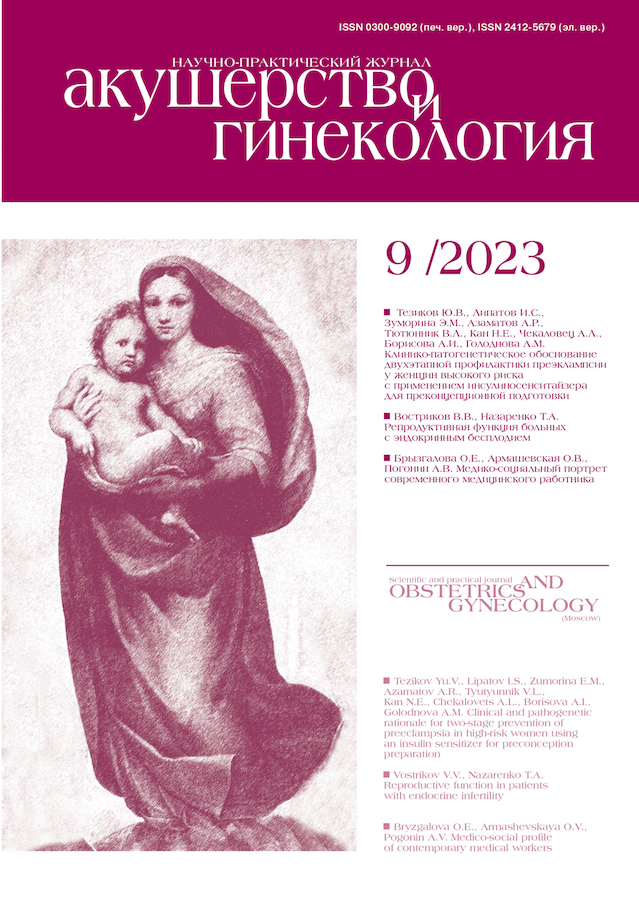The effectiveness of infertility treatment involving transfer of cryopreserved embryos obtained after autologous embryo-cumulus cells co-culture in women with repeated inplantation failure
- Authors: Asfarova G.R.1, Smolnikova V.Y.1, Makarova N.P.1, Zingerenko B.V.1, Kalinina E.A.1
-
Affiliations:
- Academician V.I. Kulakov National Medical Research Center for Obstetrics, Gynecology and Perinatology, Ministry of Health of Russia
- Issue: No 9 (2023)
- Pages: 115-120
- Section: Original Articles
- Published: 04.11.2023
- URL: https://journals.eco-vector.com/0300-9092/article/view/622969
- DOI: https://doi.org/10.18565/aig.2023.204
- ID: 622969
Cite item
Abstract
Objective: To evaluate the effectiveness of infertility treatment in the programs of cryo-embryo transfer, when embryos were obtained after autologous co-culture with cumulus cells in assisted reproductive technology (ART) programs.
Materials and methods: 198 married couples with repeated implantation failure (at least 2 attempts) were examined during the period of the study. The couples underwent IVF treatment with frozen-thawed embryo transfer into the uterine cavity. 114 couples underwent the program of autologous embryo-cumulus cells co-culture, and 84 couples underwent IVF treatment with frozen-thawed embryo transfer without using this program. Preparation of all women for cryo-transfer included cyclic hormonal treatment. Only one embryo was thawed and transferred into the uterine cavity. Pregnancy and birth rates were assessed.
Results: The study showed that autologous embryo-cumulus cells co-culture increased pregnancy rate in the group of women aged ≤35 years from 26.3% to 48.2% (OR 1.83; 95% CI 1.00–3.32) and significantly dicreases pregnancy rate in women of later reproductive age from 41.3% to 20.6% (OR 0.37; 95% CI 0.15–0.88). There was no significant difference in birth rates between the groups.
Conclusion: The results obtained in the study make it possible to recommend using autologous embryo-cumulus cells co-culture in women aged ≤35 years, who had repeated failed attempts of ART in history, to improve the effectiveness of infertility treatment.
Full Text
About the authors
Gunay R. Asfarova
Academician V.I. Kulakov National Medical Research Center for Obstetrics, Gynecology and Perinatology, Ministry of Health of Russia
Author for correspondence.
Email: asfarovag@gmail.com
Postgraduate Student, B.V. Leonov Department of Assisted Technologies for the Treatment of Infertility
Russian Federation, MoscowVeronika Yu. Smolnikova
Academician V.I. Kulakov National Medical Research Center for Obstetrics, Gynecology and Perinatology, Ministry of Health of Russia
Email: v_smolnikova@oparina4.ru
Dr. Med. Sci., Leading Researcher at the B.V. Leonov Department of Assisted Technologies for the Treatment of Infertility
Russian Federation, MoscowNatalya P. Makarova
Academician V.I. Kulakov National Medical Research Center for Obstetrics, Gynecology and Perinatology, Ministry of Health of Russia
Email: np_makarova@oparina4.ru
Dr. Bio. Sci., Leading Researcher, B.V. Leonov Department of Assisted Technologies for the Treatment of Infertility
Russian Federation, MoscowBoris V. Zingerenko
Academician V.I. Kulakov National Medical Research Center for Obstetrics, Gynecology and Perinatology, Ministry of Health of Russia
Email: b_zingerenko@oparina4.ru
Junior Researcher at the B.V. Leonov Department of Assisted Technologies for the Treatment of Infertility
Russian Federation, MoscowElena A. Kalinina
Academician V.I. Kulakov National Medical Research Center for Obstetrics, Gynecology and Perinatology, Ministry of Health of Russia
Email: e_kalinina@oparina4.ru
Dr. Med. Sci., Professor, Head of the B.V. Leonov Department of Assisted Technologies for the Treatment of Infertility
Russian Federation, MoscowReferences
- Cutting R. Single embryo transfer for all. Best Pract. Res. Clin. Obstet. Gynaecol. 2018; 53: 30-7. https://dx.doi.org/10.1016/j.bpobgyn.2018.07.001.
- Bashiri A., Halper K.I., Orvieto R. Recurrent Implantation Failure-update overview on etiology, diagnosis, treatment and future directions. Reprod. Biol. Endocrinol. 2018; 16(1): 121. https://dx.doi.org/10.1186/s12958-018-0414-2.
- Orvieto R., Brengauz M., Feldman B. A novel approach to normal responder patient with repeated implantation failures--a case report. Gynecol. Endocrinol. 2015; 31(6): 435-7. https://dx.doi.org/10.3109/09513590.2015.1005595.
- Zeyneloglu H.B., Onalan G. Remedies for recurrent implantation failure. Semin. Reprod. Med. 2014; 32(4): 297-305. https://dx.doi.org/10.1055/s-0034-1375182.
- Coughlan C., Ledger W., Wang Q., Liu F., Demirol A., Gurgan T. et al. Recurrent implantation failure: definition and management. Reprod. Biomed. Online. 2014; 28(1): 14-38. https://dx.doi.org/10.1016/j.rbmo.2013.08.011.
- Zeadna A., Son W.Y., Moon J.H., Dahan M.H. A comparison of biochemical pregnancy rates between women who underwent IVF and fertile controls who conceived spontaneously†. Hum. Reprod. 2015; 30(4): 783-8. https://dx.doi.org/10.1093/humrep/dev024.
- Larsen E.C., Christiansen O.B., Kolte A.M., Macklon N. New insights into mechanisms behind miscarriage. BMC Med. 2013; 11: 154. https://dx.doi.org/10.1186/1741-7015-11-154.
- Richani D., Dunning K.R., Thompson J.G., Gilchrist R.B. Metabolic co-dependence of the oocyte and cumulus cells: essential role in determining oocyte developmental competence. Hum. Reprod. Update. 2021; 27(1): 27-47. https://dx.doi.org/10.1093/humupd/dmaa043.
- Gilchrist R.B., Lane M., Thompson J.G. Oocyte-secreted factors: regulators of cumulus cell function and oocyte quality. Hum. Reprod. Update. 2008; 14(2): 159-77. https://dx.doi.org/10.1093/humupd/dmm040.
- Krisher R.L., Heuberger A.L., Paczkowski M., Stevens J., Pospisil C., Prather R.S. et al. Applying metabolomic analyses to the practice of embryology: physiology, development and assisted reproductive technology. Reprod. Fertil. Dev. 2015; 27(4): 602-20. https://dx.doi.org/10.1071/RD14359.
- Mansour R.T., Aboulghar M.A., Serour G.I., Abbass A.M. Co-culture of human pronucleate oocytes with their cumulus cells. Hum. Reprod. 1994; 9(9): 1727-9. https://dx.doi.org/10.1093/ oxfordjournals.humrep.a138782.
- Асфарова Г.Р., Смольникова В.Ю., Макарова Н.П., Бобров М.Ю., Эльдаров Ч.М., Зингеренко Б.В., Калинина Е.А. Клинические и молекулярные аспекты аутологичного сокультивирования эмбрионов с клетками кумулюса в программах экстракорпорального оплодотворения. Акушерство и гинекология. 2023; 4: 97-110. [Asfarova G.R., Smolnikova V.Yu., Makarova N.P., Bobrov M.Yu., Eldarov Ch.M., Zingerenko B.V., Kalinina E.A. Clinical and molecular aspects of autologous embryo cumulus cells co culture in IVF programs. Obstetrics and Gynecology. 2023; (4): 97-110. (in Russian)]. https://dx.doi.org/10.18565/aig.2022.306.
- Zhao H., Wang Y., Yang Y. Follicular development and ovary aging: single-cell studies. Biol. Reprod. 2023 Jul 28: ioad080. https://dx.doi.org/10.1093/biolre/ioad080.
- Wen X., Yang Q., Sun D., Jiang Z.Y., Wang T., Liu H.R. et al. Cumulus cells accelerate postovulatory oocyte aging through IL1-IL1R1 interaction in mice. Int. J. Mol. Sci. 2023; 24(4): 3530. https://dx.doi.org/10.3390/ijms24043530.
- Qiao T.W., Liu N., Miao D.Q., Zhang X., Han D., Ge L., Tan J.H. Cumulus cells accelerate aging of mouse oocytes by secreting a soluble factor(s). Mol. Reprod. Dev. 2008; 75(3): 521-8. https://dx.doi.org/10.1002/mrd.20779.
- Virant-Klun I., Bauer C., Ståhlberg A., Kubista M., Skutella T. Human oocyte maturation in vitro is improved by co-culture with cumulus cells from mature oocytes. Reprod. Biomed. Online. 2018; 36(5): 508-23. https://dx.doi.org/10.1016/j.rbmo.2018.01.011.
Supplementary files









